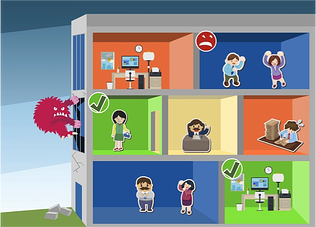Blog
Stop Scaring Your Learners: 4 Ways to Bring Life to Boring e-Learning ...
by Ann Iverson, instructional designer | @iverson_ann What is love, really? We can love our cars, homes, and flat-screen TVs, but purists will tell ...


Make a Learning Love Connection: Five FACTS for Better e-Learning Courses
By Ann Iverson | February 12, 2015 | Custom Learning | 0 Comments

by Ann Iverson, instructional designer | @iverson_ann
.png?width=120&name=Ann(250).png) What is love, really? We can love our cars, homes, and flat-screen TVs, but purists will tell you, “You can’t love things, dummy. You can only love people.” Hmmm, you sure about that?
What is love, really? We can love our cars, homes, and flat-screen TVs, but purists will tell you, “You can’t love things, dummy. You can only love people.” Hmmm, you sure about that?
I guess it all depends on how you define love. I asked Siri and she responded, “I’m not going there, Ann.” Wow, way to leave me hanging, girlfriend. Google got a bit technical, describing love as a powerful neurological condition. Apparently, the brain can release a whole set of chemicals, but let’s simplify things and view love as a way to promote long-term relationships and the feelings of confidence, contentment, and care.
So, with this definition in mind, let’s be honest. Can you openly admit your love for your last e-learning course? If you answer that with, “Yes! Yes! A thousand times, Yes!” then count yourself among the lucky in learning love. Things must have worked out and a perfect match was made. However, if you haven’t found that special connection, then it’s time to take action. I’m sure it’s not you, it’s them! So maybe it’s time to take the emotion out of the situation and stick to real FACTS to get what you need.
One thing I know for sure―great relationships begin with some sort of “let’s get to know each other” phase. At Allen Interactions (time to put on my ID hat), we call this phase Backgrounding. In our SAM process, Backgrounding helps us understand the expectations for the project, setting the stage for what a successful project outcome might look like.
I’ve found five topics to explore with stakeholders during Backgrounding that help me begin to get a glimpse of the learning solution. While I know I’m not driving the decisions around these topics, I can look for opportunities to influence them. I try to move things in a direction that, based on experience and actual research findings, will produce great results. Touching on each of these five areas, in no particular order, helps me uncover the FACTS I need to set the project up for success and move confidently into the next phase of the relationship.
Fit: How does the learning solution fit into the organization’s overall learning landscape?
E-learning courses that are part of a thoughtful learning plan are more successful than those that stand alone. In addition to linkages in the overall learning architecture, it’s important to provide support with the right mix of follow-through to reinforce key learning points and create structured ways to apply them on the job.
Fact: A company with a well-developed learning architecture is 14 times more likely to be a high-impact learning organizations, creating learning that is effective, efficient, and aligned with business goals. These organizations see triple the profit growth compared to peers. Bersin, (2014). Worksheet: Defining and Refining Your Learning Architecture
Accountability: Are learners on their own?
Accountability requires shared intention, responsibility, ownership, and commitment to improved performance. Managers who share accountability with learners help set goals, clarify expectations, and track movement as learning unfolds. Monitoring progress and measuring results are essential to the accountability process for individuals, teams, and organizations that want to build their capacity to grow and improve.
Fact: Research shows that organizations with strong coaching support have superior results. For example, organizations with “excellent” support had 13% stronger business results and 39% stronger employee results. Bersin Newsletter: Business Results Through Coaching
Control: How can learners control the learning experience?
Everyone knows that e-learning has revolutionized the way organizations train their employees. Learners have greater control over their learning than ever before, including course sequence, pacing, access of optional content, task difficulty, etc. Controlling the learning experience may allow solutions that adjust to the learners’ responses and create “adaptive pathways” for them to follow. More advanced learners can skip through some activities while those who need it can access additional resources to help them get better results.
Fact: The Research Institute of America found that the e-learning experience increases the retention rate 25-60%. This is due to the learner having control over the learning process as well as providing them with an opportunity to revisit the training as needed, which is ideal for infrequent users. e-Learning – A Strategy for Maximizing Human Capital in the Knowledge Economy
Target: How does the learning solution align with the organization’s priorities?
Understanding the strategy behind the learning solution is important to design. During Backgrounding, I try to take a big-picture view and ask target questions like, “How does the solution support your company’s goals for improved performance?” Everyone wins when resources are focused on the most important initiatives. Creating alignment to larger goals usually means getting committed support from senior leadership, often translating to real engagement and energy that trickles down to other business stakeholders. And creating a smart learning strategy produces measurable results.
Fact: High performing organizations evaluate their learning programs and tie the metrics to overall business performance measures. A research report from ATD and the Institute for Corporate Productivity reveals there is a strong correlation between goal alignment and market performance. ATD Blog: New Research from ASTD – Aligning Learning Goals and Outcomes with Business Performance Measures
Success: What does success look like and how will it be measured?
I like to ask about expected results during Backgrounding to get a clear idea of stakeholder goals. Their vision of success may be very different than what I’d assume or anticipate. Also, exploring outcomes gives me an opportunity to dig deeper and ask for definitions because the expected results help inform the design.
Like love, the evaluation of training is inherently a good thing. I like to ask where in the hierarchy (reacting, learning, performing, impacting) the solution will be measured. Reactions are important and happy sheets serve a purpose, but will they be enough to get you through the tough times? Sometimes it’s not a good thing to base decisions on feelings alone.
Research shows that one of the top ten characteristics of high-impact learning organizations is a dedicated measurement team. In a separate study, survey respondents said that the most important measures of training are those related to the impact on employees’ jobs and on the business. Bersin Press Release: Bersin & Associates Introduces New Business-Focused Approach to Training Measurement
So there you have it—five FACTS to help stakeholders fall in love with your e-learning courses. Yes, there are many other questions to ask during Backgrounding, but I find covering these five core areas helps me facilitate meaningful conversations with stakeholders right from the beginning. And that’s the perfect way to start any relationship!
And don't miss out on Learner Appreciation Month—sign up to get emails and resources today!
Want to share this post? Here are some ready made tweets:
Click to tweet: Learn the FACTS that will ensure a successful project outcome! #instructionaldesign @customelearning http://hubs.ly/y0wPrB0
Click to tweet: Learn the 5 topics to explore during backgrounding that will help get a glimpse of the learning solution. #elearning http://hubs.ly/y0wPrB0
Click to Tweet: Make a Learning Love Connection: Five FACTS for Better #eLearning Courses http://hubs.ly/y0wPrB0 #instructionaldesign @customelearning
.png?width=135&height=135&name=Ann(250).png)
About the Author: Ann Iverson
Ann is an instructional designer for Allen Interactions who’s consulted for many years with a variety of clients, industries and projects. She learns best by making mistakes!
Comments
Would you like to leave a comment?
Related Blog Posts

By: Ann Iverson | Oct, 2014
Category: Custom Learning

Blog
5 Ways to Tap into Metaphors for Better E-learning Courses
by Ann Iverson, instructional designer | @iverson_ann What is love, really? We can love our cars, homes, and flat-screen TVs, but purists will tell ...
By: Ann Iverson | Jun, 2015
Category: Custom Learning

Blog
Make 'Em Laugh: 4 Ways to Create e-Learning Courses with Humor
by Ann Iverson, instructional designer | @iverson_ann What is love, really? We can love our cars, homes, and flat-screen TVs, but purists will tell ...
By: Ann Iverson | Sep, 2014
Category: Custom Learning, Strategic Consulting
